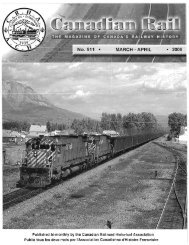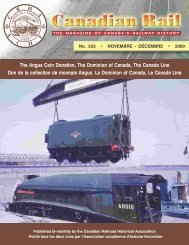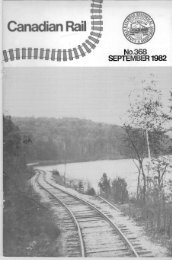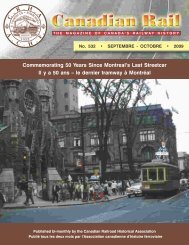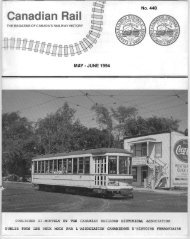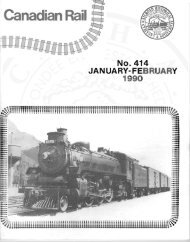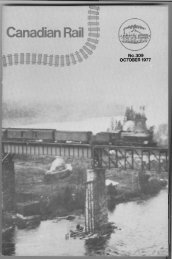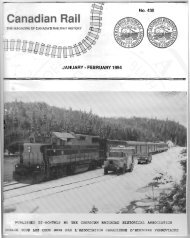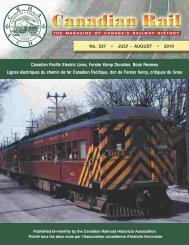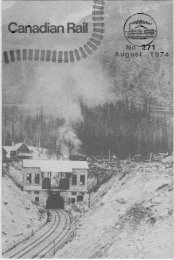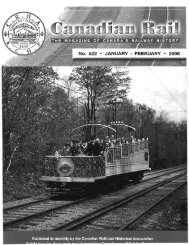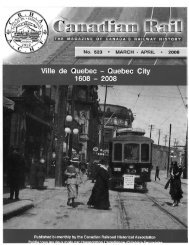Canadian Rail_no539_2010 - Le musée ferroviaire canadien
Canadian Rail_no539_2010 - Le musée ferroviaire canadien
Canadian Rail_no539_2010 - Le musée ferroviaire canadien
You also want an ePaper? Increase the reach of your titles
YUMPU automatically turns print PDFs into web optimized ePapers that Google loves.
NOVEMBER – DECEMBER <strong>2010</strong><br />
277 CANADIAN RAIL • 539<br />
The Joy of Winter <strong>Rail</strong>roading!<br />
The joy of winter railroading, CPR No. 50 at Portage La Prairie in the 1880s. CPR<br />
Archives A 17610.<br />
<strong>Le</strong>s joies hivernales du <strong>ferroviaire</strong>, la CPR no 50 à Portage la Prairie dans les<br />
années 1880. Archives CPR A 17610.<br />
In the days of steam, conditions under which<br />
railroaders work were far different from what they are<br />
today. While many of the activities are similar, the<br />
conditions, particularly in winter, are much improved.<br />
Track maintenance forces, for example, in snowstorms<br />
worked under difficult conditions cleaning track and<br />
switches. Now such modern technologies as ballast<br />
regulators and switch heaters have made the work less<br />
arduous. Perhaps the greatest change, however, has been<br />
that of locomotive engineers. Many of the activities<br />
remain the same such as observing signals and other<br />
physical objects, but the conditions under which these<br />
activities are carried out are far better.<br />
Consider the steam locomotive engineer who<br />
was required to keep a lookout for block signals, whistle<br />
posts, mile posts, flagmen, etc. failing which disastrous<br />
consequences could, and did, ensue. In order to maintain<br />
scheduled time, fast passenger trains<br />
often had to operate at 80-90 mph, and<br />
maintaining a lookout for signals, etc. at<br />
speed with very low visibility was stressful<br />
in the extreme. The identification of a<br />
block signal and its colour aspect in the<br />
second or two available required extreme<br />
vigilance. Not only the snow, but smoke<br />
and steam from the locomotive added to<br />
the hardship and visibility from the front<br />
window was impossible. The only<br />
alternative for the engineer was to keep<br />
his head out of the window in order to<br />
catch a glimpse of the imperative signals.<br />
T h e s e h a r d s h i p s w e r e<br />
dramatically demonstrated one February<br />
night in 1952 when pool train No. 6 from<br />
Toronto arrived at <strong>Canadian</strong> Pacific's<br />
Montreal West Station hauled by one of<br />
the magnificent <strong>Canadian</strong> National<br />
Northerns. The locomotive engineer was<br />
Charlie Banges, the regularly assigned<br />
engineer. The right-hand side of Charlie's<br />
face was covered with ice and he was asked whether his<br />
face was frozen. His reply was "Not at all”. The ice which<br />
formed from the snow melting on the side of my face<br />
forms a coating which protects my face from frostbite in<br />
the wind created by the train". This was a dramatic<br />
reminder of the difficulties encountered by engine crews<br />
especially in the winter months.<br />
In the days of steam whether in freight,<br />
passenger or yard service the conditions were the same in<br />
that the head had to be out of the window. The difference<br />
was that the higher the speed the more difficult the<br />
conditions became.<br />
Although the passing of the steam locomotive<br />
brought many regrets, the advent of other forms of motive<br />
power made life overall much easier on those who had to<br />
operate them.<br />
<strong>Canadian</strong> Pacific <strong>Rail</strong>way 917 a D10g ‘ten<br />
wheeler’ built by the CPR in 1911 in<br />
snowplow service on January 4, 1947 at<br />
Tweed, Ontario. Al Paterson.<br />
La locomotive D-10-g ten wheeler no 917 du<br />
Canadien Pacifique, construite par le CPR en<br />
1911, pousse un chasse-neige en ce<br />
4 janvier 1947 à Tweed en Ontario. Al<br />
Paterson.<br />
Ron Ritchie was a CPR Official who retired in 1987<br />
after forty years of service and is now living in Hudson,<br />
Quebec. He has been a lifelong student of railway histories<br />
and an avid collector of railway memorabilia. He was a<br />
close friend and associate of Omer Lavallee and Ernest<br />
Modler during their lifetimes and, besides his own, holds the<br />
railway photographic collections of both.



